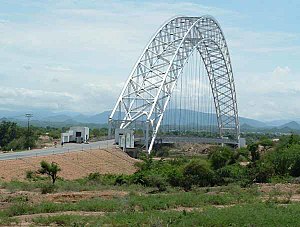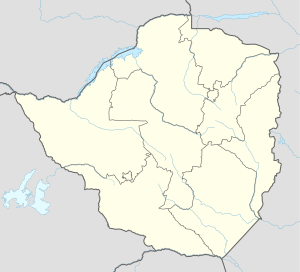Birchenough Bridge
Coordinates: 19 ° 57 ′ 44 ″ S , 32 ° 20 ′ 38 ″ E
| Birchenough Bridge | ||
|---|---|---|
| use | Road bridge | |
| Crossing of | Save | |
| place | Manicaland Province , Zimbabwe | |
| construction | Steel arch bridge | |
| overall length | 378 m | |
| width | 10 m | |
| Longest span | 329 m | |
| Clear height | 15 m | |
| start of building | 1934 | |
| completion | December 20, 1935 | |
| planner | Sir Douglas & Francis Fox | |
| location | ||
|
|
||
The Birchenough Bridge is a road bridge over the River Save (pronounced: Sa'wie) in the small town of the same name about 62 km away from Chipinge in the south of the Manicaland province in Zimbabwe . The at a height of 493 m above sea level. M. located bridge connects the cities of Mutare and Masvingo .
description
The two-lane bridge consists of a large steel truss arch, more precisely of two arch-shaped double-hinged trusses that are connected and stiffened by diagonal crossbeams. The trusses are 14 m high at the base and taper to 11.4 m at the top. The arch has a construction height of 66 m and a span of 329 m (1080 ft). The bridge board is suspended from him with wire ropes . The bridge structure is a total of 378 m long. The carriageway was originally 7.2 m wide, but was widened to 10 m in 1984. In the dry season it has a clear height of 15.2 m above the river. When it was completed, it had the third longest span of all arch bridges.
history
The bridge was one of four bridges that had been commissioned by the Beit Trust of the German-British-South African gold and diamond magnate Alfred Beit, who died in 1906 , to establish road connections in what was then Rhodesia and in southern Africa in general. The Beit Trust was led at this time by Sir John Henry Birchenough (1853-1937), after whom it was named.
The consulting engineers Sir Douglas & Francis Fox , London, were commissioned with the planning of the bridge and the corresponding road connection. At that time they were working as planning and construction management engineers for almost all railways in southern Africa. In the engineering office, Ralph Freeman was responsible for the bridge, who had already participated in the planning of the Sydney Harbor Bridge . The Birchenough Bridge was probably the first bridge from which models were previously tested in the wind tunnel. It was built from the banks by Dorman Long in cantilever construction. Ropes that had already been used when the Sydney Harbor Bridge was built were used to brace the cantilevered arch parts. After the arch was completed, these ropes were used as hangers for the bridge panel. The bridge was completed in 1935.
In 1984 it was widened and reinforced to ten meters as part of a World Bank project .
The bridge is recognized worldwide as an example of outstanding architecture. It appears to have been the model for the Ayub Bridge in Pakistan, opened in 1962 , designed by Robinson & Steinman and also built by Dorman Long .
Web links
- Birchenough Bridge. In: Structurae
- Hyder Consulting: Footprints on a global landscape - 150 years of improving the built environment ( Memento from November 24, 2013 in the Internet Archive ) (PDF; 4.3 MB)
- Birchenough Bridge with numerous photos of the construction of the bridge, on Rhodesian Heritage.blogspot
Individual evidence
- ↑ Marcel Prade: Les grands ponts du monde . Deuxième partie, Hors d'Europe. Brissaud à Poitiers, ISBN 2-902170-68-8 , p. 42
- ↑ The two longest arch bridges were the Bayonne Bridge (1931) in New York and the Sydney Harbor Bridge (1932)

